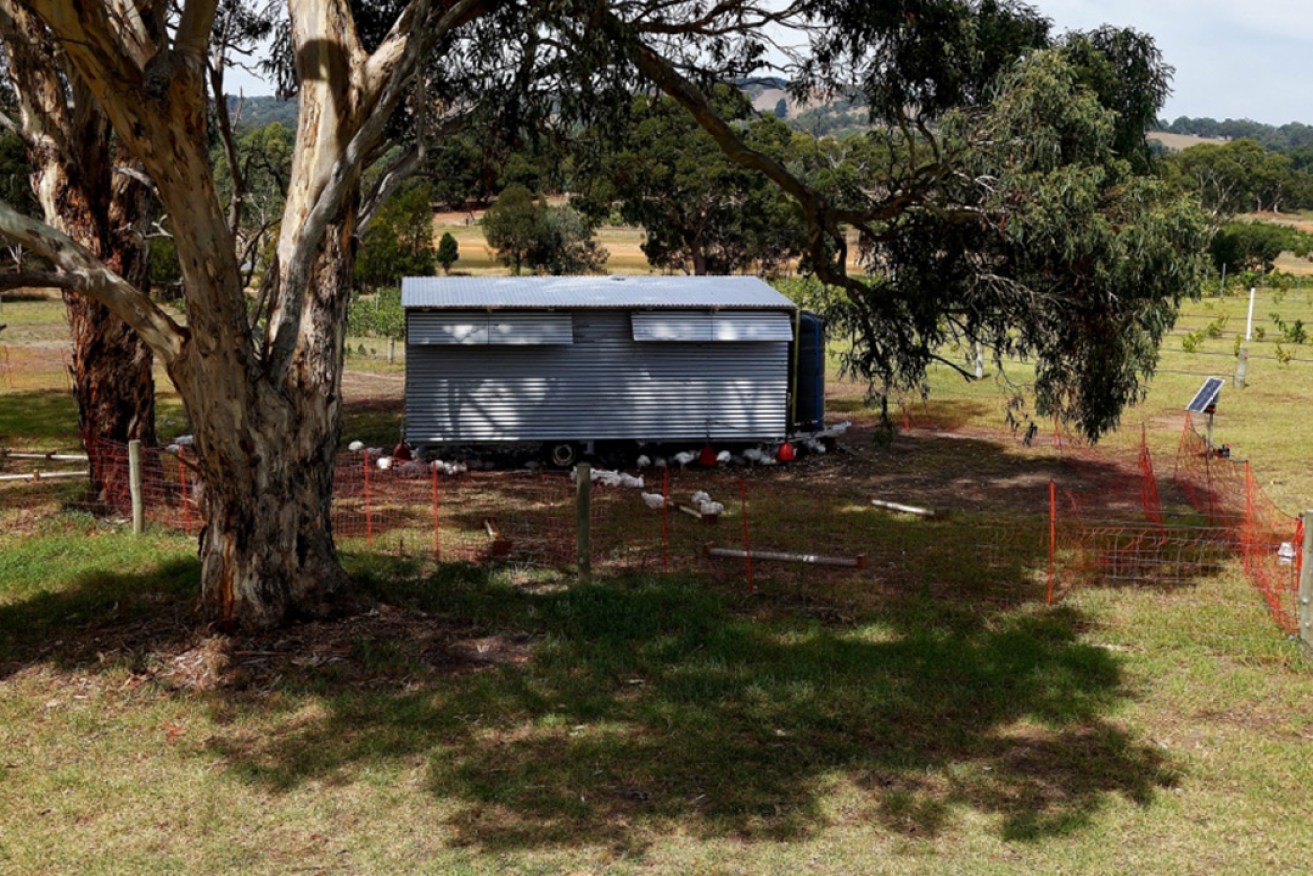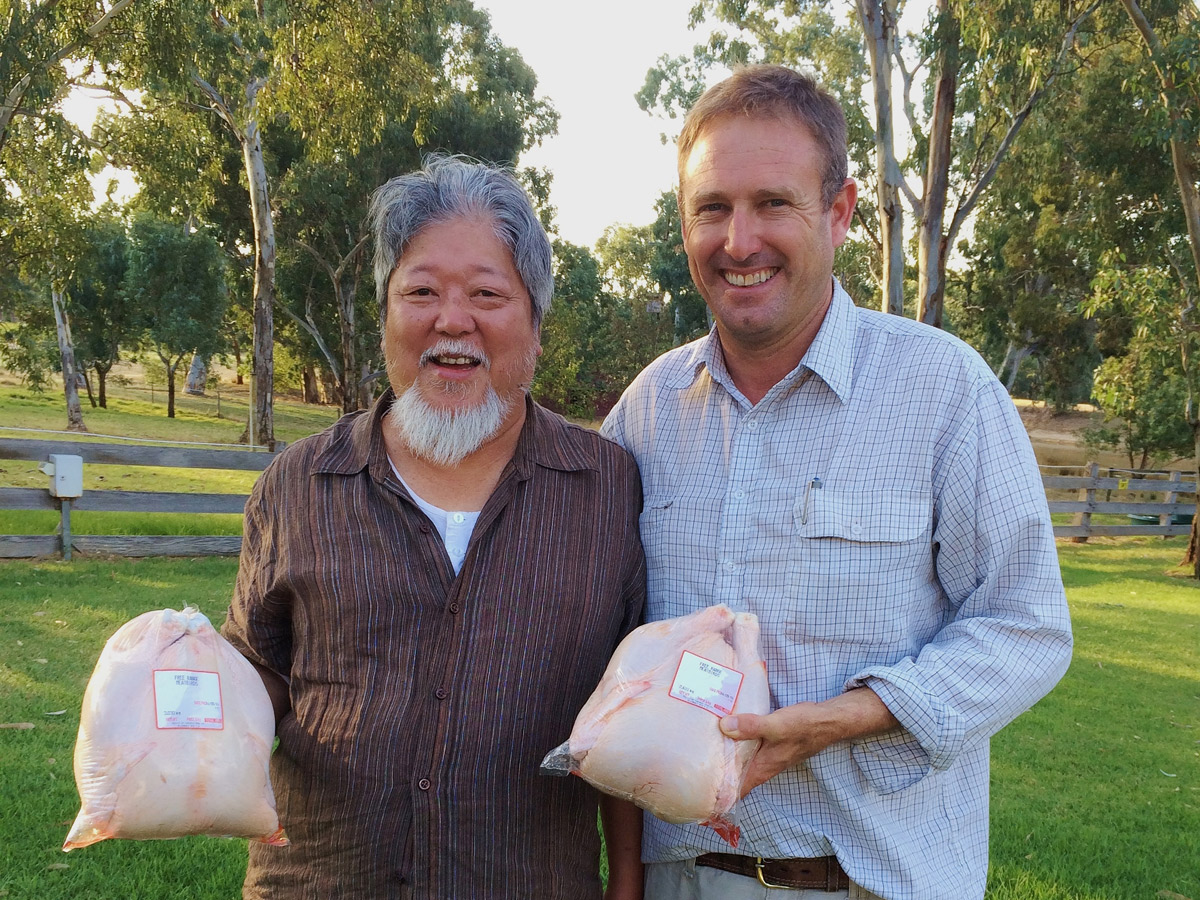Making space for chickens among the vines
Roundup: a thing you do to sheep and chooks once they’ve eaten the weeds. Whitey thinks agrochemical company Monsanto will regret the name it gave its deadly glyphosate.


On very hot days, the coop and run can be moved from the vineyard into the shade.
Greg Trott, founder of the modern Wirra Wirra, often chortled while recalling McLaren Vale’s days as a domestic fowl and egg-producing centre.
After World War II, when all the shell-shocked lads came home to remember what farming was like, the wine business was in disarray, and even those with established family vineyards found it necessary to run several businesses on the one property. Orchards, nuts, stock, grain, dairy … anything that could be squeezed onto a block was attempted alongside the growing of currants and wine grapes.
This often involved a reach back into past farming practices; a certain rekindling of old-fashioned habits that might have required harder work, but returned a more wholesome, ecologically-sound result.
For some years, chooks were the go. There were many meat birds raised around the Vales when I began paying attention in the ’70s, but in the ’50s and ’60s, great populations of laying hens were common all the way from Stump Hill along Pedler Creek through McLaren Flat and right up the Blewett Springs gullies to the brink of the Onkaparinga Gorge.
Their manure was a very handy vineyard fertiliser in the days before mindless petrochem monoculture.
There was a tax on laying fowl. Other than the marauding foxes, the region’s most hated intruder was the gubmnt chook inspector.
While the old hand-plugged party-line telephone system was the most modern form of communication, its lack of privacy, although usually hated, made possible simultaneous communication between all the chook farmers. Whenever the dreaded whitecoat approached with his ledger, it’d be all lines open with the message: “The Enemy is amongst us”.
To make the counting of the birds nigh impossible, they’d all be released from their sheds and cages and chased onto the wild open range. When the inspector arrived to demand an accurate count, the farmer would retort: “Well I dunno how many there are. I can’t get ’em in the shed. You round ’em up and count ’em.”
One of Trotty’s most humorous recollections was the co-operative matter of getting the birds down from the trees and back into their coops once The Enemy had retreated to the city. Maxwell, Dennis, Osborn, Genders, Kay, Trott … some very famous wine names would form hilarious chook posses.
All this came to mind at the beginning of vintage, when a handsome new five-star fowl hotel appeared in the vineyard outside my kitchen. A well-ventilated galvo structure, it was custom-built on a big four-wheel trailer chassis.
Peter Fraser, my landlord, had raised many local eyebrows with his replacement of agrochemical company Monsanto’s dreaded Roundup with lambing ewes in the Yangarra vineyards five or six years back; now we see sheep everywhere through the winter, right across the district. Once the vines are dormant, weeds generally proliferate. Sheep now turn this vegetation into neat little balls of biodynamic fertiliser.
Monsanto loses out on the Roundup sale. It loses again on its petrochem fertiliser account. And the vigneron makes money selling the lambs: when the vines begin to shoot in spring, the sheep are removed. Noted chefs queue for the dressed lambs and the ewes are returned to their standard pasture elsewhere on the range.
Now Peter’s having another go at the vineyard chook, the doubters’ eyebrows have raised a touch higher.
Trott’s chortles and the great fowl round-ups came to mind last week when the Feds announced that free-range eggs could now be officially laid by chooks farmed at an intensity of one bird per square metre. Ki-yi-yippee ki yay.
Peter’s prototype chookhouse was built to sleep only about 250 birds. Using a solar-powered electric fence of lightweight roll-up mesh, the birds were given about one square metre of roaming range per head, but the whole thing was moved every few days, so they always had fresh ground to forage, and their shit never became thick enough to kill everything.
On very hot days, the whole business was moved out of the vines and into the shade.
Bacchus only knows how the modern gubmnt chook monitor would police such errant non-conformism.
“Yeah mate, they only get one metre each but every few days it’s a fresh metre.”
This first trial flock were baby meat birds not bred to forage, but forage they did, tentatively. With supplementary feed, they were fat enough for table within a couple of months and were dressed the old-fashioned way by Kapowie Poultry near Kapunda. Kapowie is the only professional chicken processor in the state to do the slaughtering and packaging without the bleach and stuff that blights all other commercially-processed fowl.
These fine chooks were also spared the injection of water, a neat guarantee of extra weight in your mass-produced deep-frozen bird.
Peter sold all his 240 chooks in a few hours of Twitter and Facebook action. Cheong Liew, that genius master chef from Kuala Lumpur’s biggest chook farming family, was first in the queue. We shared a few reds on my verandah while he waited for the dressed birds to come back south from Kapowie, a great grin on his face.

Chef Cheong Liew with Peter Fraser, chicken farmer, general manager and winemaker at Yangarra Estate. Photo: supplied
At the other end of the impending winter, at bud burst, the 2016 vintage sheep will come out of the vineyards, their fat biodynamic lambs will be processed and sold, and Peter will mount a much more serious attempt at his chook enterprise.
He has plans for a lighter, more mobile coop, and perhaps a different strain of bird. He’ll try laying fowl, and think about the breeds that might forage harder, eat more pests and even assist in the management of tricky stuff like Kikuyu grass, Pennisetum clandestinum, the tropical East African Gĩkũyũ native introduced to grow lawns in Australia.
Cease using the standard glyphosate and you’ll find Kikuyu rampant in previously hard-farmed, weathered soils, especially in freak summer rains like the record falls of last January. Kikuyu loves drought-breaking rains, and predominates very quickly when there is no rival vegetation already established.
Add some proper foraging fowl to the sheep effort, and fingers crossed, the lawn might be held back sufficiently to let a richer texture of native grasses take hold before vintage 2017.
Cheong, who understands the advantages of jungle chooks, suggests the introduction of a bantam rooster to the flock. Reading Professor Barbara Santich’s great book, McLaren Vale – Sea and Vines, I notice that at the annual shows of the McLaren Vale Poultry and Kennel Club early last century, breeds as diverse as Plymouth Rock, Silver-spangled Hamburg, Andalusian, Indian Game and Black-red Malay fowl were grown.
Santich also reports the showing of Toulouse geese, and Aylesbury, Rouen and Indian Runner ducks.
Who knows how long it’ll be before we can buy a biodynamic Indian Game fowl raised in bush-vine Grenache and fattened on Roussanne skins before the sheep take their turn in the vineyard?
In McLaren Vale, for starters at least, Monsanto will eventually regret the name it gave its deadly glyphosate weedicide. Roundup is once again something you do to sheep. And chooks. After they’ve eaten the weeds.
I can hear Trotty chortling.




